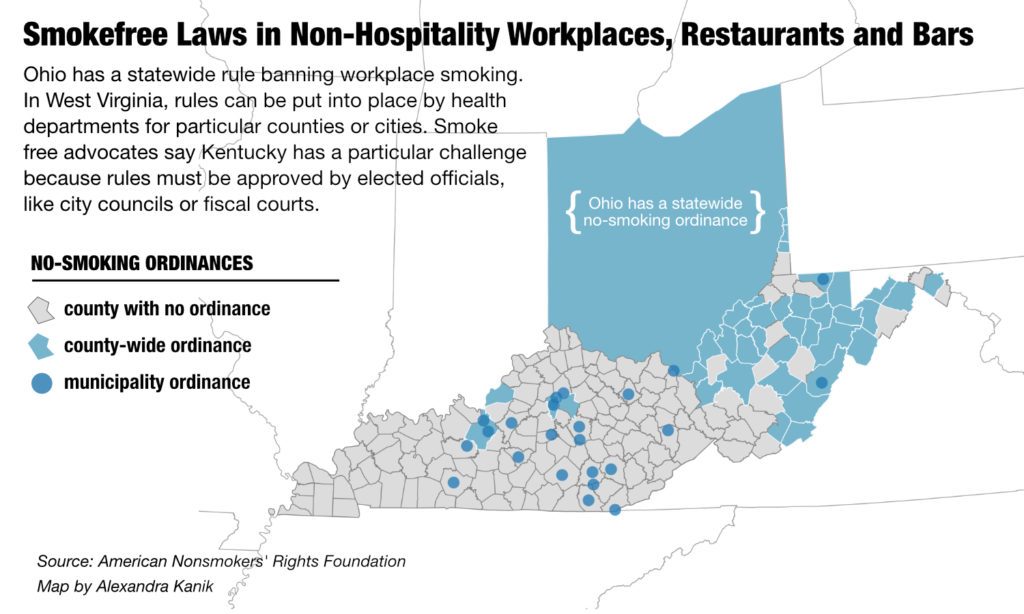News
Tobacco’s Toll: New Push To Stop Smoking In Country’s Sickest States
By: Mary Meehan | Ohio Valley ReSource
Posted on:
Hundreds of kids scurrying to buses are oblivious to a sign above them declaring Bourbon County High School “100 percent Tobacco Free.” But upstairs in the library, sophomore and anti-smoking advocate Jacob Steward unfurls a six-foot scroll with earth-toned papers trapped between clear sheets of laminate. He begins reading the anti-smoking slogans he’ll post around the school.
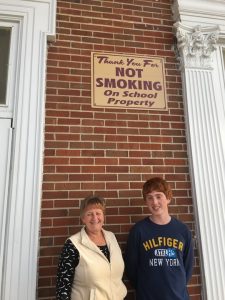
“E-cigs pose threat to health and turn kids into addicts and gives big tobacco your money,” he said. “E-cigs, neither water, vapor or harmless.”
Steward is well aware that while his high school campus is smoke free, his central Kentucky community is not. Many kids wander off to a nearby lot to smoke. And many of the Bourbon County businesses where teens work part-time still allow smoking, exposing kids and other workers to secondhand smoke.
In fact, about 60 percent of Kentucky communities do not have an ordinance requiring workplaces to ban smoking. Data from the Centers for Disease Control show Kentucky and West Virginia have the highest rates of teen smoking in the country.
With bright red hair, sharp blue eyes and braces, Jacob is the face of Students Making A Change in their Communities, or SMACK. He also reflects the region’s tobacco heritage. His family has long been in the tobacco growing business. Both his parents are long-time smokers, although his mom has switched to vaping.
He said kids are using nicotine to cope with anxiety and often progressing to other addicting drugs. Kids including his best friend from middle school, who got in busted for trading vaping supplies with high school kids after his mom went to prison. That boy and others, he said, seek out nicotine.
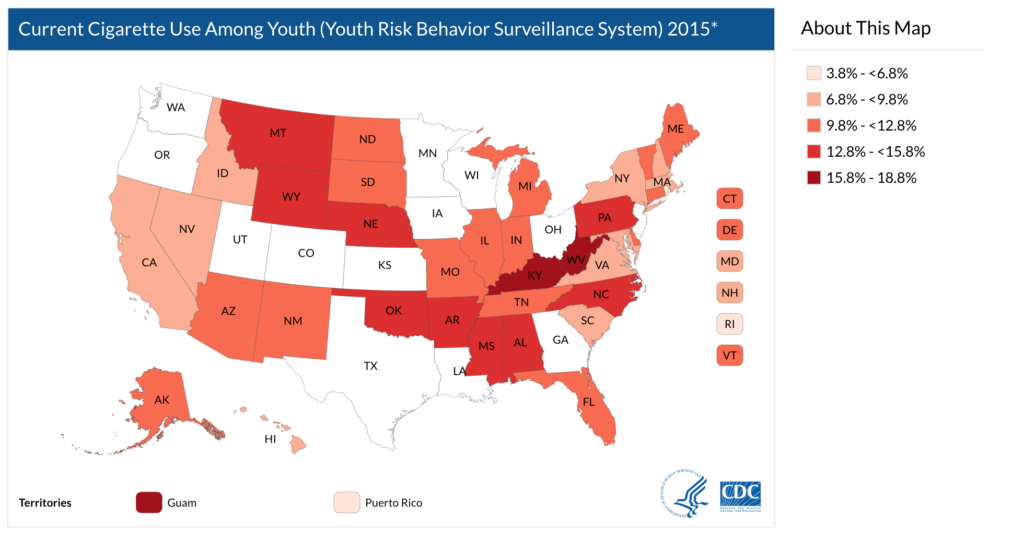
“They try to fill that void with a drug or something that takes their mind off it for a little while, off the things that are happening in their home life,” he said.
Tobacco Nation
Kentucky, West Virginia and Ohio make up a third of what the anti-smoking group the Truth Initiative recently dubbed the “Tobacco Nation.” It’s a “country within a country” with high rates of smoking and tobacco-related diseases such as lung cancer and heart failure. People who live there tend to die young than in the rest of America. But Jacob and others are still working to solve the region’s original addiction crisis.
Ben Chandler, president and CEO of the Foundation for a Healthy Kentucky, said there is rightly a lot of discussion lately about the opioid crisis and the toll of heroin addiction in communities. But he said the region has two big addiction problems. The other?
“The nicotine in tobacco.”
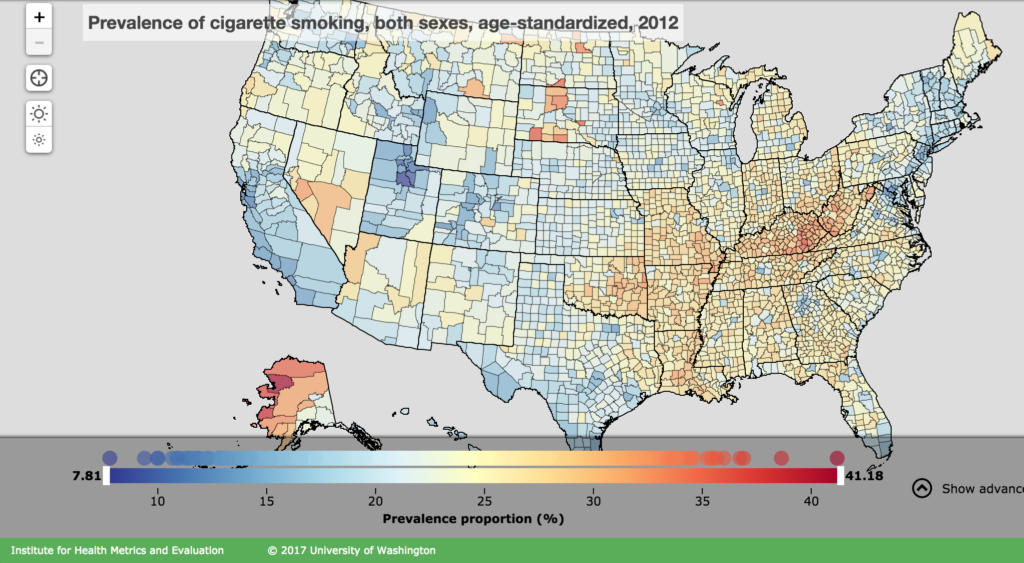
Opioid overdoses claimed about 1,400 lives in Kentucky last year. According to the foundation, tobacco use and secondhand smoke kills nearly 9,000 Kentuckians each year and results in health care costs of $1.92 billion.
While Kentucky is perhaps the starkest example of tobacco’s toll, similar statistics are common around the The Ohio Valley region.CDC data show Kentucky and West Virginia have some of the highest adult and teen smoking rates in the country, and Ohio’s smoking rates are well above the national average.
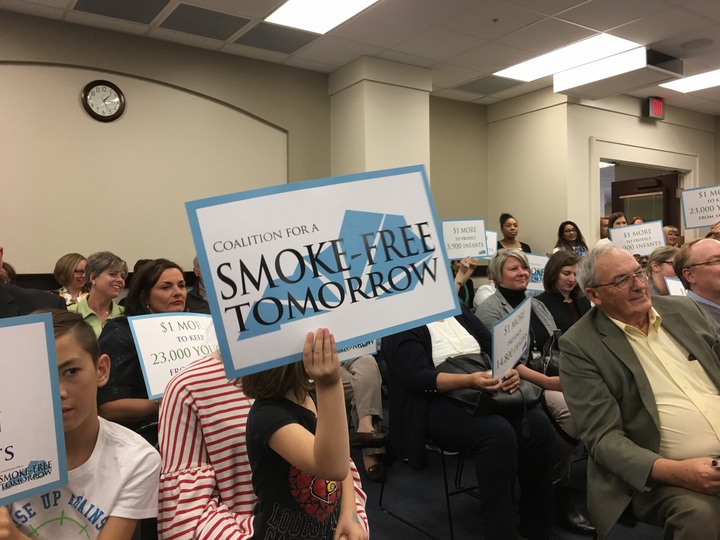
Chandler leads Smoke-Free Tomorrow, a collection of organizations ranging from the Kentucky Chamber of Commerce to the council of churches. They launched their latest fight against smoking at a recent rally in Frankfort, where Chandler said there are some readily available tools to change those grim statistics.
“We have two very easy answers at hand,” he said. “Increase the cigarette tax by a dollar or more, and smoke-free laws all across this state.”
Price Point
Kentucky taxes cigarettes at 60 cents–among the ten lowest state taxes in the country. Chandler said the $1 hike is important. If the price doesn’t rise by at least that much, he said, the increased costs are offset by coupons and special deals by tobacco companies.
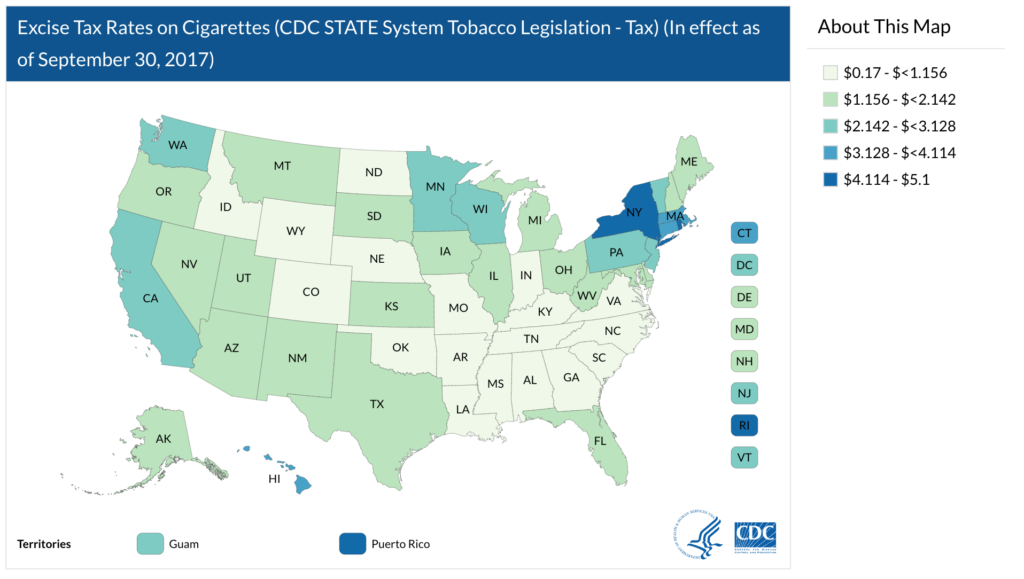
Ellen Hahn is the director of a tobacco-control advocacy group at the University of Kentucky called BREATHE, which stands for Bridging Research Efforts and Advocacy Toward Healthy Environments.
She said raising taxes has been proven to be an effective tool in both keeping people from starting to smoke and pushing people to quit. But only at the right price point.

“Make sure the price of tobacco is high enough to keep people who are price sensitive, like youth, pregnant women and low income populations, off of tobacco,” she said.
But while smoke free ordinances and tax increases have been successful across the country, here in the Ohio Valley region, she said, for every step forward like there is a step back.
In West Virginia, for example, while about three-fourth of West Virginians live in places with a smoke-free workplace law, this summer the state slashed staff in its smoking prevention program, eliminating all but one of eight positions.
Ohio, she said, has had a statewide workplace ban on smoking for a decade but still has high rates of smoking and the diseases associated with tobacco use.
But, she said, she that change is happening because the issue is so complicated. “It there was an easy answer we would have found it by now.”
Tobacco Tradition
And then there is the issue of the tradition and historic importance of tobacco in the region. Even in Lexington, one of the first places in the state to enact smoking restrictions, visitors to Hahn’s BREATHE office are likely to walk through a smoke-filled sidewalk to get to her door.
That deeply rooted connection with tobacco is something Cyndi Steele knows well. Steele is the advisor to Jacob Stewart and the SMACK team. She’s been an advocate at the Bourbon County Health Department for 24 years and knows the heritage of smoking.
“It goes back to heritage,” she said. “It’s what put Christmas in the house, it’s what paid the farm bill, it put kids through college, it built the courthouse. That’s what I heard for years, is ‘that tobacco built the courthouse’.”
“But it certainly does not do that anymore,” she said, “and when you know better you do better.”
Changing Times
Jacob’s grandparents, whom he calls Nan and Pa, had 65 acres of tobacco in 2014. Now it’s just 10. Instead of growing a product that can harm people, they are now growing mums. Jacob is proud that the mums grown by his family are used in school fundraising projects in Bourbon County. That, he said, means it is a positive for both the family and the community.
Plus, he said, the perception of growing tobacco is changing.
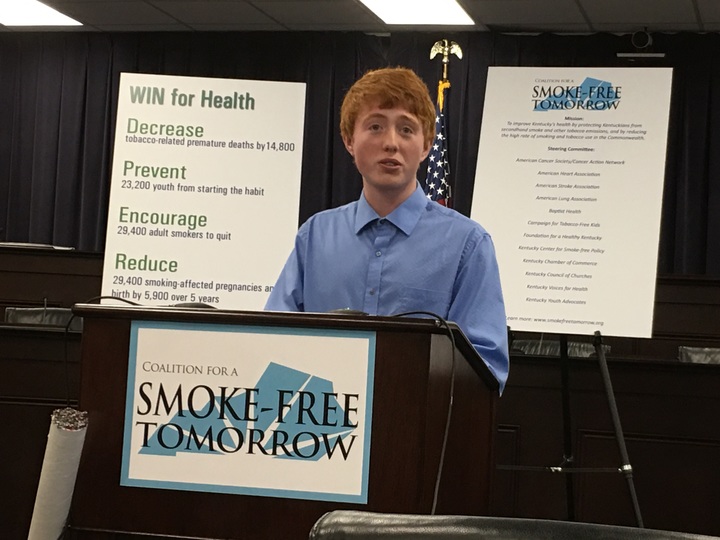
“It is really just people realizing how dirty of a business tobacco is and people getting involved and understanding the risks of tobacco.”
He’s worked the fields himself and can rattle off each painstaking step of the process from soaking the tobacco stakes in bleach to carefully putting the seeds in the correct place for the most growth.
He’s not a fan.
“It’s hot and it’s sweaty and a lot of times it’s nasty,” he said.
Jacob said this is the year that Bourbon County will get a smoking ordinance. He’s got a winning strategy for convincing elected officials. One he’s perfected on his still-smoking mom.
Nagging.
“When are you going to quit. When are you going to quit,” he said. “After a certain point of pestering, they get tired of hearing it.”


